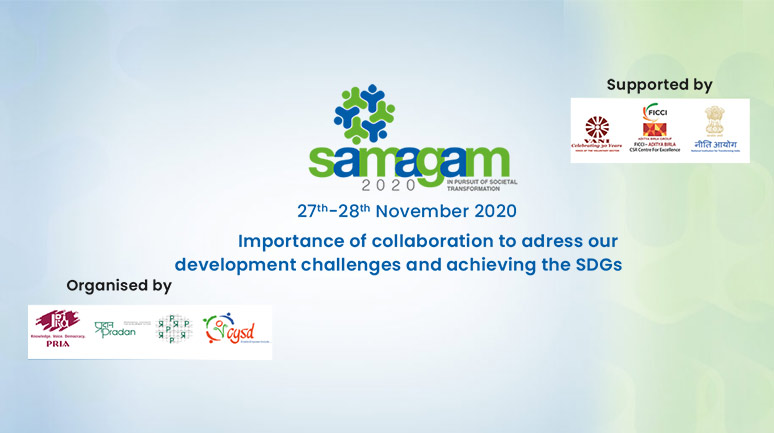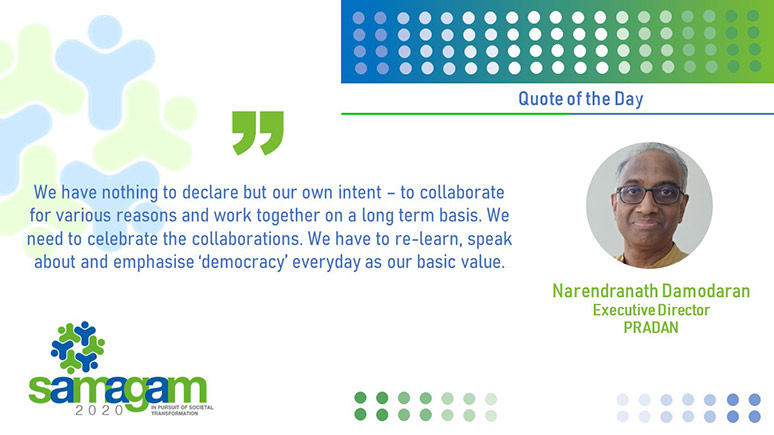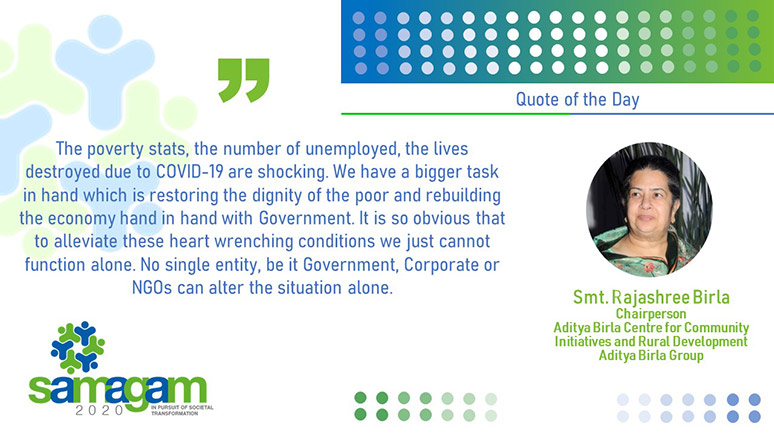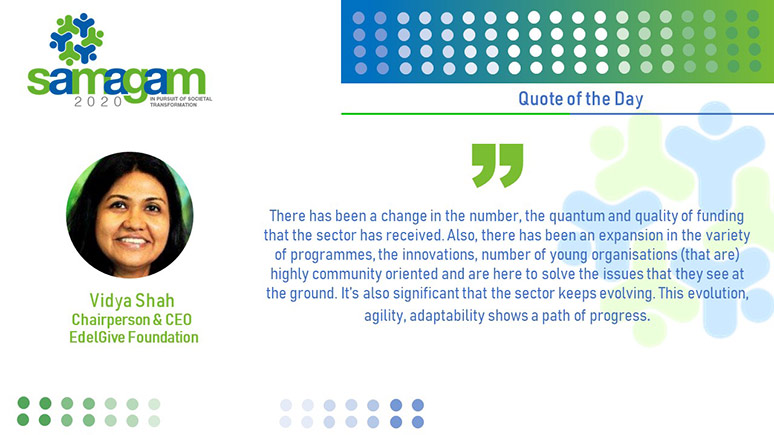Samagam 2020


"If you want to go fast, go alone. If you want to go far, go together"
I n November 2019 PM Modi announced his ambition to make India a $5 trillion economy by 2024, and in a pre-budget exercise at NITI Aayog at the start of 2020 discussed a host of suggestions for reviving economic growth and improving engagement between policy makers and diverse stakeholders towards achieving that aim. Even as the country was taking steps towards this grand ambition the juggernaut of COVID-19 brought to a halt the economy pushing more people than ever before into joblessness and poverty.
Covid-19 exacerbated the inequalities in Indian society and disproportionately impacted the poor and marginalized. The reverse migration of millions of hitherto invisible Indians - for the first time shone the spotlight on the wretchedness of their condition and the fact that they deserved better. It raised the collective conscience of middle-class India, moving the migrant workers from the shadows to front and center of debates about ethics of free market forces and those who live on the periphery of society.
After the initial missteps India saw an unprecedented coming together of governments, corporates and civil society organizations to support migrants and rural India. The Covid-19 experience has removed any doubts about how inextricably countries, communities and societies are linked, and how closely they need to work together to make this world a better place for everyone.
Samagam 2020 was held on the 27th and 28th of November against this backdrop. What also formed the backdrop was an increasing concern about the space and encouragement that was being given to Civil Society Organizations (CSOs) to do what they are supposed to do best – contribute, and sometimes lead, the process of development work in the country. The FCRA and CSR Amendments proposed clearly seem to cast a shadow on the work of CSOs, and seem to seek greater regulation and limit their “corridors of freedom” to do meaningful work.
Samagam 2020 however chose to tell and celebrate the story of the successful State-Corporate- CSO collaborations that had effectively alleviated the demonic proportions of the Covid-19 effects and after effects, and which had over the last couple of years shown the way to address the challenges that threaten our world and communities - health, nutrition, livelihoods, education, women’s rights, domestic violence etc. It chose to present itself as a platform for the key development sector stakeholders to reiterate their commitment to working together to create a more just, inclusive, equitable and sustainable world.
The African proverb, “If you want to go fast, go alone. If you want to go far, go together”, captures the essence and inspiration of Samagam very well, even though it found expression only in Samagam 2020. Samagam, as it was conceived and launched in April 2018 was always envisioned as a meeting point or coming together of the key development sector stakeholders – the State, the Market, and the Civil Society – Sarkaar-Bazaar-Samaaj. Samagam was envisaged as a platform that would seek to dismantle the barriers that come in the way of collaborative working, and ensure we find ways and means to make our communities and society more resilient, and growth more equitable and sustainable. Samagam sought to unleash an ongoing process of coming together, thinking together and working together to ensure we reach far, rather than travel fast.
Humble beginnings were made on the 18th April 2018, PRADAN’s Foundation Day, almost as an epilogue to PRADAN’s Annual Retreat (congregation of all PRADAN professionals to reflect on the year gone by and refresh and recharge themselves for the task and year ahead). However, the first edition of Samagam (2018) gave enough indications that a platform that strongly focused on tripartite collaboration and SDG-17 was a worthy idea to pursue, if we were to meet the other sixteen SDGs we were committed to, and overcome our development challenges.
It took us over a year to farm out the concept of Samagam to the development sector and move it away from being a PRADAN offering to being a sectoral production. Even as Covid-19 propounded the concept of social distancing, development sector stakeholders came together like never before to try and overcome the challenge of Covid-19. The period also saw Samagam realizing its ambition of becoming a platform for inter-sector collaboration to address our development challenges, beyond Covid-19.

C ollaboration was a thread that ran right through Samagam 2020. Three key CSOs – Participatory Research in Asia (PRIA), Centre for Youth and Social Development (CYSD) and Professional Assistance for Development Action (PRADAN) – came together to design and organize the event; three key representative bodies of the State (NITI Aayog), Corporates and Industry (FICCI) and CSOs (VANI) agreed to support and endorse the platform; all the sessions – keynote and breakaway sessions – had speakers and partners across the three stakeholder groups. A refreshing change from some of the earlier platforms, which tend to skew towards one of these stakeholder groups in terms of participation or voices and viewpoints heard.
Smt. Rajashree Birla, Chairperson, Aditya Birla Center for Community Initiatives and Rural Development, in her opening address highlighted the fact that we are faced with the task of restoring the dignity of the poor and rebuilding the economy post Covid-19 - a task that no single entity, whether Government, Corporate or NGO could achieve on its own. She extolled the need for different actors and stakeholders, to “pull together in the same direction” to rebuild the economy in all its facets and submitted to the house that it seemed “intuitively right to collaborate at every level” to overcome the development challenges facing us a country at this stage. Dr. Yasmeen Ali Haque, Representative India Office, UNICEF, highlighted the need and relevance of engaging with CSOs for “community-based monitoring” to help appreciate the scale and nature of challenges facing us, and putting in place public “social protection programs” for the vulnerable and marginalized communities, especially women, children and the girl child. Shri Subroto Bagchi, Chairman Odisha Skill Development Authority, while appreciating the effort of Samagam 2020 to refocus on our SDG tasks and challenges, urged the gathering to keep an eye on the “big picture” – that no development work or SDG could be accomplished on the foundation of an ill-fed and ill-clad work force. He challenged the development sector stakeholders to transition from the concept of “minimalism” (minimum wages, minimum prices, minimum programs, etc.) to one of “maximalism” if India@100 were to be anywhere close to being “atmanirbhar" – something that it had not been able to move closer to in its 75 years of independence.

While the keynote addresses laid bare some of the challenges facing the country, especially in the context of Covid-19, and espoused the need for “coming together”, “working together” and pulling together”, the projects across themes of Rural Livelihoods, Watershed Management, Education, Migration Challenges, Covid-19 Response, Youth and Mental Health, and Health and Nutrition provided evidence of what great collaborations could deliver on the ground. Besides the project content and experience what was also heartening and fascinating was that each of these initiatives were presented and shared by respective teams represented by stakeholders across State, Corporates/Foundations and CSOs. Many of the sessions also had voices from the communities that each of the projects were designed to serve. Not surprisingly some of the themes that emerged from the sessions and deliberations highlighted the following:
- Partners across different stakeholder groups, and sometimes within the same stakeholder group, usually bring in a different and differentiated value into a collaboration. It is important for people and organizations to accept and respect that and leverage it for the success of the project. Successful collaborations happen when partners respect each other as equals and are not looking to dominate or dictate terms.
- Collaborations are critical to help scale up pilots and new ideas. Many an individual player maybe good at bringing in a new idea and making it work as a pilot. However, as someone mentioned, “pilots don’t fail, but pilots don’t scale”. Development work requires doing work and effecting change on scale, and if ideas and pilots need to work on scale, they necessarily need multiple partners and stakeholders to come together and collaborate to achieve a shared vision and goal.
- All development work needs to have communities at the center – if your communities are not part of defining/prioritizing the problem(s) and arriving at the solution(s), then you are bound to fail, sooner or later. Solutions to problems that are not identified by communities, and not owned and co-created by communities are not sustainable.
- It is thus important to listen to grassroots organizations that are in close and constant contact with communities, and have their ears to the ground and the trust of the communities they work with.
- Development work needs to have targets and milestones, but collaboration creates greater value in development projects rather than competition. It is thus important to align vision, define roles and have mutual trust and respect to deliver impact and effect change.
- The process of monitoring and evaluation (and course correction if necessary), also needs to be defined and followed jointly, in an atmosphere of mutual trust and respect. Stakeholders need to be accountable to each other and the project at hand, and should be willing to take joint responsibility for both success and failures.
- Communication is key. Open, frank communication, setting clear expectations, and sharing what an individual or organisation can’t do, and asking help for the same is critical, no matter how big or small the organisation is.
- Development agencies, Corporates and CSOs do not have a (long) history of collaborating with each other, in a boundless way. Development work is multi-sectoral, the philosophies and ethos of the stakeholders are different – we need to be aware and conscious of that and allow for many conversations, deliberations and framing and reframing of the problem(s) and its solution(s).
As the discussions unfolded, it was highly encouraging to see most stakeholders warming up to the thought that collaboration is the only way to succeed in overcoming our complex, intersectional development challenges, and that we need to make the collaboration work, come what may, to stand a chance to succeed. It was fascinating to see some speakers actively defend the need and benefits of collaborations even as a couple of other speakers championed the thought that collaborations might be only a “fashionable” thing to do or talk about, while they may be unnecessary and inefficient in many circumstances. Even as Anurag Behar, CEO, Azim Premji Foundation, suggested that stakeholders tended to “collaborate” only when it was easy to do so, and there were really no real “collaboration among equals” or on challenging tasks that really needed collaborations that were tough to achieve, no one seem to leave the conference doubting the reality of the African proverb, “If you want to go fast, go alone. If you want to go far, go together.”

L est people feel that collaboration was only an emotional, feel good factor to resort to, Vijay Mahajan, CEO, Rajiv Gandhi Foundation, Co-founder PRADAN, in his own, inimitable style presented to the house a simple formula that would decide if collaborations were worth their while for the partners and collaborators, or would individual stakeholders choose to “walk on their own”. He argued that for collaborations to succeed/sustain both the following conditions need to be satisfied:
- The total net outcome (or benefit) of the collaborative work should necessarily be more than the sum of the outcomes (benefit) that the individual players could achieve/deliver, and
- The net benefit accruing to each of the partners/collaborators should be more than the net benefit that each one of them could seek to achieve individually, for themselves.
He further submitted that while condition 1 is non-negotiable and the basic premise of a good collaboration, in case condition 2 above was not achieved in some cases, it was up to the partners/ collaborators to “subsidize costs” or “supplement benefits” of some individual players in the interest of achieving condition 1 above.
Dilip Chenoy, Secretary General FICCI went out on a limb to whole-heartedly support collaboration, saying that “Collaboration is the next form of competition”. Besides espousing the possibilities of the large number of CSOs and Corporations (especially MSMEs) collaborating among themselves, he championed the cause of CSO-Private Sector-State coming together and bringing into play their respective strengths of Trust (of communities CSOs work with), Execution expertise (of the private sector) and managing programs on Scale (by the State) to truly deliver the “power of collaboration”.
As a management graduate who has been part of the Corporate world, building competitive advantage and preferences for Brands for over 25 years, I must admit I have myself been truly humbled by the power and thrill of collaboration, and the pursuit of greater good for greater numbers rather than personal gain. During one of my early field trips in PRADAN work areas I had the chance to meet one of the women members of National Smallholder Poultry Development Trust (NSPDT), which supports more than 11,000 women poultry rearers across 23 producer organisations. After she shared her story of moving from a stage when she, like many others, had to cut her saree into three pieces to afford a change of clothing, to one now when the NSPDT and her Village Organisation Members were doing their own CSR – supporting higher education of deserving girl students – I was naturally tempted to ask her, “So what next didi? What’s your next goal?” She replied quite simply and naturally, “We have about 120 families in our village, and currently women from only 90 of these families are a part of the Co-operative. We want to try and get the other didi into the fold too, so that they can also benefit from this business as we have all to date.”!! She did not want to keep the success formula to herself, but wanted to grow together!!
Covid-19 has clearly demonstrated to us how interconnected we are, and that we are only as strong as our weakest link. And that is a lesson we should not forget in a hurry. Sushma Iyengar, the founder of Kutch Mahila Vikas Sangathan, during one of my interactions with her, mentioned that “when people are vulnerable they are really at their best and they become interdependent on other people which creates a completely different environment". Covid-19 has shown how vulnerable each one of us is, and how we need to come together, to overcome together, or fail. I hope we will continue to accept our vulnerability as individuals, as organizations, as communities, as nations, without having nature to remind us of that, and will continue to think together, build together and celebrate together.
A s we pick our learnings from Covid-19 and Samagam 2020, what needs to be seen is how much of this will translate into real action and journeys of collaboration. Will we have many more success stories of collaboration to share the next year at Samagam 2021? Or will we still be asking ourselves:
- Why do we need to collaborate? Can't we be as effective or more if we work by ourselves?
- What can I do to enable collaborations?
- What are my stumbling blocks? What stops me from working together?
- What can I do to overcome the impediments?
- What will I do to create a more enabling ecosystem for large scale collaborations?
- What is the cost and consequences of collaborating and not collaborating?
Please visit the Samagam Website for the session wise video recordings and reports.


1 Comment
Thanks dear sir